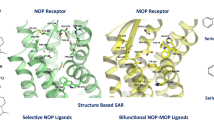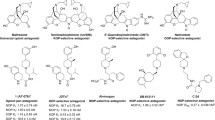Abstract
The recently discovered fourth member of the opioid receptor family, the nociceptin receptor (NOP) and its endogenous ligand, the heptadecaptide nociceptin, are involved in several central nervous system pathways, such as nociception, reward, tolerance, and feeding. The discovery of small-molecule ligands for NOP is being actively pursued for several therapeutic applications. This review presents a brief overview of the several recently reported NOP ligands, classified as NOP agonists and antagonists, with an emphasis on the analysis of the structural features that may be important for modulating the agonist/antagonist profile (intrinsic activity) of these ligands. Structure-activity relationships in our own series of dihydroindolinone-based NOP ligands and those of the various reported ligands indicate that the lipophilic substituent on the common basic nitrogen present in all NOP ligands plays a role in determining the agonist/antagonist profile of the NOP ligand. This analysis provides a basis for the rational drug design of NOP ligands of desired intrinsic activity and provides a framework for developing pharmacophore models for high affinity binding and intrinsic activity at the NOP receptor. Since NOP agonists and antagonists both have therapeutic value, rational approaches for obtaining both within a high-affinity binding class of compounds are very useful for designing potent and selective NOP ligands with the desired profile of intrinsic efficacy.
Similar content being viewed by others
References
Bigoni R, Giuliani S, Calo' G, et al. Characterization of nociceptin receptors in the periphery: in vitro and in vivo studies.Naunyn Schmiedebergs Arch Pharmacol. 1999;359:160–167.
Mollereau C, Mouledous L. Tissue distribution of the opioid receptor-like (ORL1) receptor.Peptides. 2000;21:907–917.
Mogil JS, Pasternak GW. The molecular and behavioral pharmacology of the orphanin FQ/nociceptin peptide and receptor family.Pharmacol Rev. 2001;53:381–415.
Calo' G, Guerrini R, Rizzi A, Salvadori S, Regoli D. Pharmacology of noniceptin and its receptor: a novel therapeutic target.Br J Pharmacol. 2000;129:1261–1283.
Zaveri N, Polgar WE, Olsen CM, et al. Characterization of opiates, neuroleptics, and synthetic analogs at ORL1 and opioid receptors.Eur J Pharmacol. 2001;428:29–36.
Lutfy K, Eitan S, Bryant C, et al. Buprenorphine-induced antinociception is mediated by mu-opioid receptors and compromised by concomitant activation of opioid receptor-like receptors.J Neurosci. 2003;23: 10331–10337.
Zaveri N. Peptide and nonpeptide ligands for the nociceptin/orphanin FQ receptor ORL1: research tools and potential therapeutic agents.Life Sci. 2003;73:663–678.
Ronzoni S, Peretto I, Giardina GA. Lead generation and lead optimization approaches in the discovery of selective, nonpeptide ORL-1 receptor agonists and antagonists.Expert Opin Ther Patents. 2001;11:525–546.
Zaveri NT, Jiang F, Olsen CM, et al. A novel series of piperidin-4-yl-1,3-dihydroindol-2-ones as agonist and antagonist ligands at the nociceptin receptor.J Med Chem. 2004;47:2973–2976.
Wichmann J, Adam G, Rover S, et al. Synthesis of (1S,3aS)-8-(2,3,3a,4,5,6-hexahydro-1H-phenalen-1-yl)-1-phenyl-1,3,8-triazaspiro[4,5]decan-4-one, a potent and selective orphanin FO (OFQ) receptor agonist with anxiolytic-like properties.Eur J Med Chem. 2000;35:839–851.
Rover S, Adam G, Cesura AM, et al. High-affinity, non-peptide agonists for the ORL1 (orphanin FQ/nociceptin) receptor.J Med Chem. 2000;43:1329–1338.
Rover S, Wichmann J, Jenck F, Adam G, Cesura AM. ORL1 receptor ligands: structure-activity relationships of 8-cycloalkyl-1-phenyl-1,3,8-triaza-spiro[4.5]decan-4-ones.Bioorg Med Chem Lett. 2000;10:831–834.
Ito F, Ohashi Y, inventor. Pfizer, Inc., assignee. 1,3,8-Triazaspiro[4,5]decanone compounds as ORL1-receptor agonists. European patent application, European patent 0 997 464 A1. July 10, 1999.
Kolczewski S, Adam G, Cesura AM, et al. Novel hexahydrospiro [piperidine-4,1′[3,4-c]pyrroles]: highly selective small-molecule nociceptin/orphanin FQ receptors agonists.J Med Chem. 2003;46:255–264.
Tulshian D, Ho GD, Silverman LS, et al, inventor. Schering Corporation, assignee. High affinity ligands for nociceptin receptor ORL-1. US patent 6 262 066 B1. July 17, 2001.
Chen Z, Miller WS, Shan S, Valenzano KJ. Design and parallel synthesis of piperidine libraries targeting the nociceptin (N/OFQ) receptor.Bioorg Med Chem Lett. 2003;13:3247–3252.
Kawamoto H, Ozaki S, Itoh Y, et al. Discovery of the first potent and selective small molecular opioid receptor-like (ORL1) antagonist: 1-[(3R,4R)-1-cyclooctylmethyl-3-hydroxymethyl-4-piperidyl]-3-ethyl-1, 3-dihydro-2H-benzimidazol-2-one (J-113397).J Med Chem. 1999;42:5061–5063.
Ozaki S, Kawamoto H, Ito Y, Hayashi K, Hirano K, Iwasawa Y, inventor. Banyu Pharmaceutical Co., assignee. New 2-oxoimidazole derivatives. US patent 6 258 825. July 10, 2001.
Kawamoto H, Ozaki S, Ito, Y, Iwazawa Z, inventor. Banyu Pharmaceutical Co, assignee. 4-Oxoimidazolidine-5-spiro-nitrogen-containing heterocyclic compound. Japan patent application 20001169476. June 20, 2000.
Zaratin PF, Petrone G, Sbacchi M, et al. Modification of nociceptin and morphine tolerance by the selective ORL-1 antagonist (−)-cis-1-methyl-7-[[4-(2,6-dichlorophenyl)piperidin-1-yl]methyl]-6,7,8,9-tetrahydro-5H-benzocyclohepten-5-ol (SB-612111).J Pharmacol Exp Ther. 2004;308:454–461.
Shinkai H, Ito T, Iida T, Kitao Y, Yamada H, Uchida I. 4-Aminoquinolines: novel nociceptin antagonists with analgesic activity.J med Chem. 2000;43:4667–4677.
Yamada H, Nakamoto H, Suzuki Y, Ito T, Aisaka K. Pharmacological profiles of a novel opioid receptor-likel (ORL1) receptor antagonist, JTC-801.Br J Pharmacol. 2002;135:323–332.
Muratani T, Minami T, Enomoto U, et al. Characterization of nociceptin/orphanin FQ-induced pain responses by the novel receptor antagonist N-(4-amino-2-methylquinolin-6-yl)-2-(4-ethylphenoxymethyl) benzamide monohydrochloride. In:J Pharmacol Exp Ther. vol. 303. 2002:424–430.
Mabuchi T, Matsumura S, Okuda-Ashitaka E, et al. Attenuation of neuropathic pain by the nociceptin/orphanin FQ antagonist JTC-801 is mediated by inhibition of nitric oxide production.Eur J Neurosci. 2003;17:1384–1392.
Mouledous L, Topham CM, Moisand C, Mollereau C, Meunier JC. Functional inactivation of the nociceptin receptor by alanine substitution of glutamine 286 at the C terminus of transmembrane segment VI: evidence from a site-directed mutagenesis study of the ORL1 receptor transmembrane-binding domain.Mol Pharmacol. 2000,57:495–502.
Author information
Authors and Affiliations
Corresponding author
Additional information
Published: October 5, 2005
Rights and permissions
About this article
Cite this article
Zaveri, N., Jiang, F., Olsen, C. et al. Small-molecule agonists and antagonists of the opioid receptor-like receptor (ORL1, NOP): Ligand-based analysis of structural factors influencing intrinsic activity at NOP. AAPS J 7, 34 (2005). https://doi.org/10.1208/aapsj070234
Received:
Accepted:
DOI: https://doi.org/10.1208/aapsj070234




